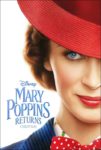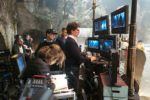 “We were all a little terrified, “ joked sound designer/supervising editor Renee Tondelli, when questioned about working on Mary Poppins Returns, the sequel to Disney’s iconic film Mary Poppins. Actually, Tondelli and her crew were very excited. The film was her fifth collaboration with Rob Marshall and the third musical that she has done with the director. Tondelli added, “I absolutely knew he would be fantastic at it. With Emily Blunt as Mary Poppins, it was a no-brainer.”
“We were all a little terrified, “ joked sound designer/supervising editor Renee Tondelli, when questioned about working on Mary Poppins Returns, the sequel to Disney’s iconic film Mary Poppins. Actually, Tondelli and her crew were very excited. The film was her fifth collaboration with Rob Marshall and the third musical that she has done with the director. Tondelli added, “I absolutely knew he would be fantastic at it. With Emily Blunt as Mary Poppins, it was a no-brainer.”
The musical singing parts were recorded live on set. Marshall does four or five takes with the music playing loud so that the actors can sing along, because it is very important that they really sing, not lip-sync, because the audience can tell when someone is not singing. Then the director would have the performers sing without any music playback, sometimes with ear buds or possibly a click track in their ear. When it comes time for editing, Marshall picks the best performances. The sound department will then incorporate the production recordings, the studio pre-records, and ADR to get the best and most believable vocal performance.
Tondelli is proud of all the work on the film, but her favorite sequence is the Royal Dalton Music Hall. “That was so much fun,” commented Tondelli. “When we got it, it was just green screen and pencil drawings. We didn’t know what these animals were going to look like. We didn’t know how many would be on the stage. We heard there were going to be penguins. There were little men in green suits, four of them being penguins. We had no idea of what they would look like or sound like.”

The stage was a flat with green cloth over boxes. They were told there would be books made of different materials. When recording the dance foley, co-choreographer Joey Pizzi came in and repeated all the dance moves. Tondelli wanted the movement to be organic. She did not want to break up the sounds, such as the leather steps or paper steps, in different passes as is normally done. Instead she setup leather, wood, paper and slate stages so Pizzi could jump on and off the different stages depending upon whatever material he knew he would be dancing upon.
The sequence was also fun for the dialog of the animated characters, which was created from scratch in post. During production the only characters on set were the kids on a bench and Mary and Jack onstage. The hand-drawn animation came in very slowly. Only when she got partial drawings, did Tondelli become aware of the full scope of the sound her team would have to produce.
Tondelli went to London and recorded for five days. The animal audience that sang along with Mary could be drunk and not sing as well, while the assumption for the stage animals was that they were better singers since they were onstage, yet they all had to be in perfect timing so the performance was not sloppy to the point of not understanding the lyrics. The different animal voices, such as the high soprano flamingos and the deep basso elephant, also needed to be distinguishable from each other. Hundreds of performers were needed to realistically fill the venue. At the recording session Tondelli had some of the animations, but most importantly, she had the song and the rhythm to work with.
“A music hall in London is very bawdy and big and rowdy,” shared Tondelli. “I went to London and hired about 70-80 actors that could sing. They also had to be animals. They had to become an elephant that could sing, but also call out, and do voices, and not be cartoony. It was really tricky to create this wild, raucous sing-a long.”
In additional to several additional production numbers–each having a myriad of challenges– the film also had subtle family moments filled with emotion, making the sound a delicate balancing act. Starting with a dark tone in keeping with 1930’s London, the soundscape, along with with the visuals, brought in more and more happiness. Marshall’s overall concept for the film was for everything to be “dipped in realism.” Tondelli interpreted that vision as “magical realism.” And the magic has truly been captured on screen.





